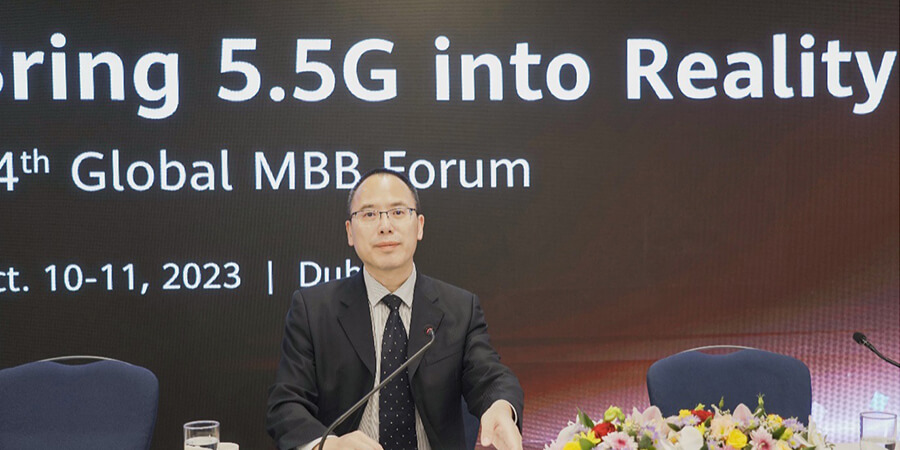Telecom Review participated in a media roundtable organized on the sidelines of the Global Mobile Broadband Forum 2023, where Cao Ming, President of Huawei Wireless Solution, elaborated on Huawei's cutting-edge advancements.
Huawei's Leap into 5.5G
In the ever-evolving world of wireless technology, staying ahead of the innovation curve is a necessity. Cao Ming stated that Huawei has been at the forefront of this movement. He unveiled the company's plans for 5.5G.
He explained that while 5G has already brought remarkable improvements in user experiences, this is just the beginning. Effectively, the future holds even more exciting possibilities with the advent of 5.5G.
Accomplishments in the Middle East
In the context of the Middle East, Telecom Review raised pertinent questions regarding the region's progress.
Cao Ming shed light on the Middle East's proactive engagement in 5G deployment and Huawei's collaborations with leading operators in the Middle East. He added that the Middle East's proactive approach to 5G technology is driving rapid progress in the region. With networks maturing and infrastructure growing, 5.5G is on the horizon.
“Leading operators in the region have been actively engaged in discussions with Huawei regarding the development and deployment of 5G and 5.5G.” Indeed, during the Mobile World Congress in February this year, du and stc, signed memoranda of understanding (MOU) with Huawei, marking significant strides in the region's 5G journey towards 5.5G.
He also mentioned that du and Huawei unveiled the world's first 5.5G villa at this year’s MBBF, enabling users to experience glasses-free 3D gaming and more, all powered by 5.5G connectivity. Furthermore, stc collaborated with Huawei to verify passive IoT, the key innovation that brought by 5.5G, in July.
With its full-series, full-scenario 5.5G products, Huawei is committed to ensuring operators a seamless transition from 5G to 5.5G and that the long-term investments of telecom operators are protected.
Paving the Way for Africa: Bridging the Digital Divide
The President of Huawei Wireless Solution stated that Africa is on its journey towards adopting 5G technology, but progress varies across the continent. Different countries are at different phases of development, with some still relying on 2G and 3G technologies, and some have already benefited from 5G networks. The decision to embrace a specific generation of mobile technology depends on factors like service needs, economic development and ecosystem maturity.
“South Africa serves as a prime example, with 5G networks deployed in major cities, while 3G still dominates in certain rural areas. Huawei has been working to provide diverse solutions for different scenarios and markets. In hotspot areas, they've deployed FDD massive MIMO for high capacity while offering lightweight solutions for remote rural areas. All of these solutions are designed to be ready for 5G technology.”
Huawei recognizes that the commercial availability of 5G or 5.5G in a given region is determined by the maturity of the ecosystem and market development. The company's commitment to providing a diverse set of solutions ensures that countries and industries can smoothly transition to the latest mobile technology when the time is right.
The Pillars of Huawei's 5.5G Solutions
For Huawei’s cutting-edge solutions, Cao Ming explained five main pillars to achieve the promised capabilities of 5.5G networks:
- Ultra-Wideband: Huawei's solutions support a wide range of frequency bands, eliminating the need for telcos to deploy multiple pieces of equipment to accommodate non-contiguous bands.
- Multi-Band: Huawei's solutions offer multi-band support, enabling telcos to use one piece of equipment to support different bands. This approach reduces deployment costs and alleviates the burden on antenna space.
- Multi-Antenna: Huawei continues to innovate and integrate multiple antennas into their solutions, significantly increasing spectral efficiency and improving user experiences. This can potentially reduce spectrum licensing costs for telcos.
- Green Technology: Huawei pays a lot of attention on energy efficiency. Since the network is increasingly complex, Huawei’s approach of “0 bit 0 watt” achieves energy consumption on demand, ensuring that the network consumes less energy when no traffic is low. This is vital to reducing environmental impacts and operational costs.
- IntelligentRAN: Huawei's autonomous driving network, also known as IntelligentRAN, aims to simplify network management and maintenance, making 5.5G networks more cost-effective and efficient.
The Road Ahead: Collaborative Efforts and Regulatory Support
As Huawei takes the lead in developing 5.5G solutions, it emphasizes the importance of industry collaboration and regulatory support to ensure success. To make 5.5G a reality, Huawei encourages industry partners and regulatory authorities to facilitate the development of 5.5G ecosystems and applications. This support includes mechanisms to engage device manufacturers, application developers and ecosystem partners in the 5.5G development journey.
Moreover, financial support and incentives, such as subsidies and tax benefits, can be provided by local governments to encourage businesses to embrace 5.5G technology. These initiatives can play a pivotal role in promoting the rapid adoption of 5.5G, reducing the digital divide and transforming industries across the globe.
“With Huawei's commitment to innovation and collaboration, 5.5G is on the horizon, promising remarkable advancements in wireless technology and a more connected world. As the digital era continues to evolve, Huawei remains at the forefront, dedicated to pioneering the future of wireless communication,” concluded Cao Ming.










